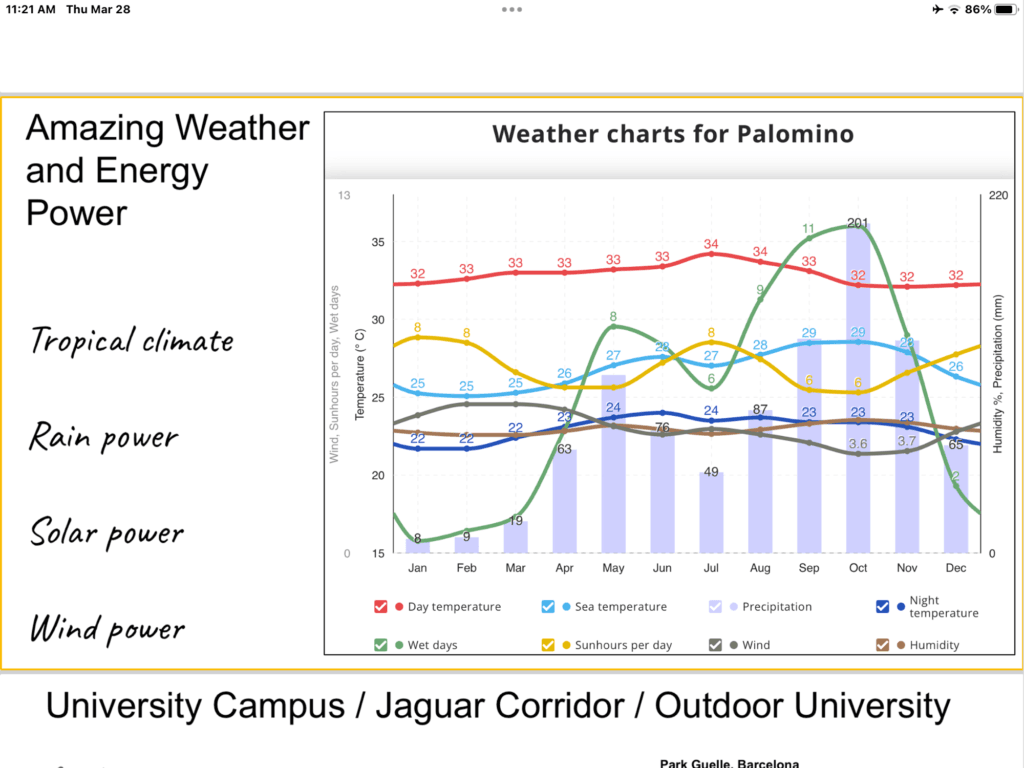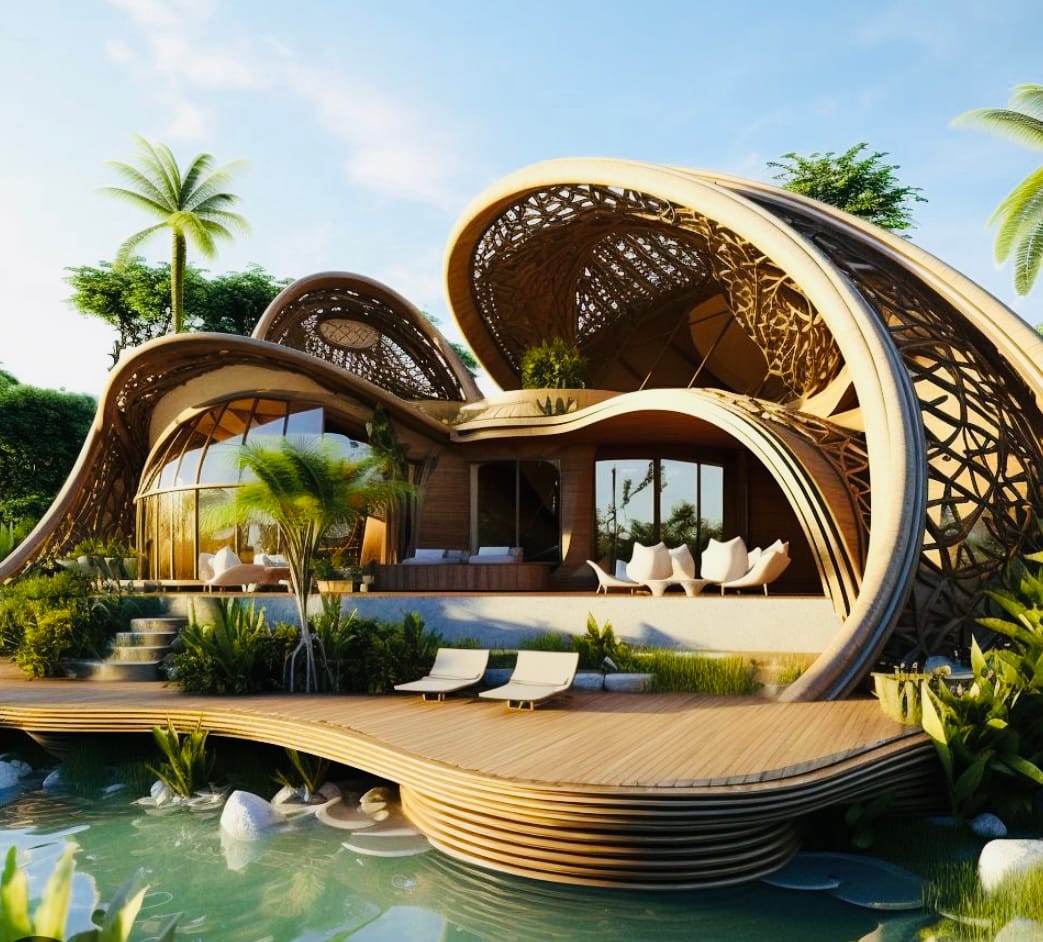Campus Structure
The university directors have scouted land in Colombia that provides the perfect environment for development of the campus of the university/ Esperanza Land, as a sovereign peace region, to build the first micronation. The different regions that compose Esperanza Land are as follows:
- Parche: A parche is a peace zone of about one hectare and includes one main home and three guest houses. A family (scholars at the university), take the role of custodians, regenerating her and making the land sovereign.
- Village: A village is composed of 14 hectares, including 13 parches (13 hectares) and an additional one hectare for community infrastructure (main temple, market place).
- Micronation: A micronation is composed of 12 villages, all working together to foster peace, prosperity and sovereignty.
- Jaguar Path: The Jaguar Path is composed of peace zones, connecting the previous peace lands. It can be a road, a predetermined trajectory in earth, water or air. Is a path for all to walk free in harmony and peace.
In these zones, we develop regeneration principles, new technologies, new education systems, new health systems, new economies while building inner peace, with our families, parches, villages, micronations and the whole world. The campus implements sustainable solutions in harmony with mother earth. The campus is designed as a tribe living experience where schools and health centers are at a short walking distance, with public places, where communities come together to play music, plant trees, and host meetings. The campus designs and implements its own water and energy systems that provide energy and water sovereignty to towns. It also provides services, clothing, food and earth medicines, etc. produced in the campus by specialized villages.
Custodianship of the parches is strategically allocated depending on their interest and the energetical archetype that they bring to the village, maximizing peace and wealth creation.. The university creates profiles based on their astrology and numerology archetypes.
Sierra Nevada, Magdalena Colombia
With amazing weather, the campus is nested in the indigenous reserve of la Sierra Nevada de Santa Marta. The planned land is 360 km2 (36,000 hectares). This is about the size of Philadelphia or Detroit in the US), which is less than 2% of the land inside the black line protecting la Sierra Nevada Land (19,000 km2). It will host an average of 500,000 people year around, including 144,000 local twin flames. This land is returned back to Pachamama (can never be sold), becoming custodians walking the path of sovereignty and harmony.

The first land that the founders aquire is in the Marquetalia/Palomino area, a small village of the department of Magdalena. It enjoys tropical water, as well as great potential to gather solar and wind power.

Social Structures
The campus is organized in parches that are organized by school interests. A parche is composed of one hectare 12 couples who live in 3 hectares. Each couple is given a house with a block of land and they live with family friends and invited scholars. The 3 hectares also hosts a temple. The temple is a Maloka type building where sacred ceremonies are held. It is a building to be used by the community for education and healing purposes.
A village is composed of 12 parches living in 36 hectares. The village also provides a temple for ceremonies.
Each scholar in their Hieros Gamos Journey is given a block of land with a house, for them to play the role as custodians.
Villages are self sufficient and support each other. Each village is self sufficient and trades with other villages goods and services. They can share, for example a water well. All houses have solar panels and batteries to charge devices. Villages have trees, fruits, vegetables, earth medicines, herbs, etc., for their population, including neraby communities they supoort.
This video shows ideas of the houses that we are building
Temples and University Hubs
Temples are University Hubs that serve to support the education/research community needs (e.g. permaculture lab), and to hold meetings, ceremonies, and teachings from the scholars that live in the village. Hubs serve as a community center that provide educational, health and other services. For example, an artists studio hub can be an open maloca with direct connection with the air, water, sun, stars, moon, and fauna and flora part of the surroundings. The hub, contains all materials needed to materialize the creative expressions of the artists.
Scholars meet at the hubs for the main activities and interact with conscious creators. Students have opportunities to create art with an artist in the artist studio, plant seeds with a local farmer, create movies with a professional movie maker, build a house with an architect, research on the medical compounds of earth medicines, compose a song with a musician, etc.
Sustainable Solutions
The campus implements sustainable solutions in harmony with mother earth. The campus is design as a tribe living experience where schools and health centers are at a short walking distance, with public places, where communities come together to play music, plant trees, host meetings. The campus designs and implements its own water and energy systems that provide energy and water sovereignty to towns. It also provides services, clothing, food and earth medicines, etc. produced in the campus by specialized villages.
The founders have depicted several locations to build the campus. They have a mountain location, a hub in Palomino, and other possible land around the north east coast of Colombia. An example of a town that is suitable for an amazing campus is Rio Ancho. A town developed near the pristine Rio Ancho river, that flows from the high snow peaks to the ocean, providing crystalline, pure water to the community as well as a cool breeze, refreshing in those warm days.
Silvania, Cundinamarca Colombia
coming soon …

